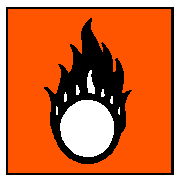International Chemical Safety Cards
| SODIUM DICHLOROISOCYANURATE | ICSC: 0437 |
| SODIUM DICHLOROISOCYANURATE Dichloro-s-triazine-2,4,6-trione; sodium salt C3HCl2N3O3.Na Molecular mass: 220.96 CAS # 2893-78-9 RTECS # XZ1900000 ICSC # 0437 UN # 2465 EC # 613-030-00-X |
 |
 |
| TYPES OF HAZARD/ EXPOSURE |
ACUTE HAZARDS/ SYMPTOMS |
PREVENTION | FIRST AID/ FIRE FIGHTING |
| FIRE | Not combustible but
enhances combustion of other substances. Gives off irritating or toxic fumes (or gases)
in a fire. |
NO contact with flammable
substances. NO contact with strong reducing agents, strong bases, ammonia, urea, water. |
Powder, alcohol-resistant
foam, water in large amounts, carbon dioxide. |
| EXPLOSION | Risk of fire and explosion
on contact with strong reducing agents, strong bases, ammonia, urea, water. |
|
In case of fire: cool
drums, etc., by spraying with water but avoid contact of the substance with water. |
| EXPOSURE | |
PREVENT DISPERSION OF DUST!
STRICT HYGIENE! |
|
| INHALATION | Cough. Sore throat.
|
Local exhaust or breathing
protection. |
Fresh air, rest. |
| SKIN | Redness. Skin burns.
Pain. |
Protective gloves.
Protective clothing. |
Remove contaminated
clothes. Rinse skin with plenty of water or shower. Refer for medical attention. |
| EYES | Redness. Pain. Loss of
vision. Severe deep burns. |
Face shield, or eye
protection in combination with breathing protection if powder. |
First rinse with plenty of
water for several minutes (remove contact lenses if easily possible), then take to a
doctor. |
| INGESTION | Burning sensation. Sore
throat. |
Do not eat, drink, or smoke
during work. |
Rinse mouth. Do NOT
induce vomiting. Rest. Refer for medical attention. |
| SPILLAGE DISPOSAL | STORAGE | PACKAGING & LABELLING | ||
| Evacuate danger area!
Consult an expert! Do NOT wash away into sewer. Sweep spilled substance into dry
containers. Carefully collect remainder, then remove to safe place. Do NOT absorb in
saw-dust or other combustible absorbents (extra personal protection: complete protective
clothing including self-contained breathing apparatus). |
Separated from food and
feedstuffs, see Chemical Dangers. Dry. Well closed. |
Airtight. Do not transport
with food and feedstuffs. O symbol Xn symbol R: 8-22-31-36/37 S: (2-)8-26-41 UN Hazard Class: 5.1 UN Packing Group: II |
||
| SEE IMPORTANT INFORMATION ON BACK | ||||
|
||||